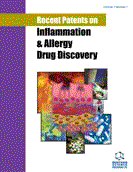Abstract
Background: Etiologic diagnosis of pediatric chronic urticaria is quite challenging, as few cases can be associated to specific triggers. Thus, more than 50% of chronic urticaria in children are labeled as idiopathic. Several evidences supported an autoimmune pathogenesis in 30-40% of patients with idiopathic (or spontaneous) chronic urticaria in adults, where the diagnosis of autoimmune chronic urticaria included in vivo and in vitro tests, revealing the presence of autoantibodies against high-affinity IgE receptors mainly.
Objective: This review aimed at collecting and analyzing all the available evidences on the diagnosis and treatment of autoimmune chronic urticaria in children, including most recent developments and patents.
Results and conclusion: Most pediatric studies relied on autologous serum skin test only, in order to evidence autoimmune urticaria. A complete diagnostic assessment of pediatric autoimmune chronic urticaria, demonstrating an antibodymediated mechanism of disease, might ameliorate the therapeutic management of spontaneous (autoimmune) chronic urticaria in children, supporting the use of omalizumab rather than immuno-suppressive therapy in cases resistant to the firstline treatments.
Keywords: Anti-IgE receptor autoantibodies, autoimmune chronic urticaria, autologous serum skin test, basophil histamine release test, cyclosporine, omalizumab.
 55
55 3
3


















